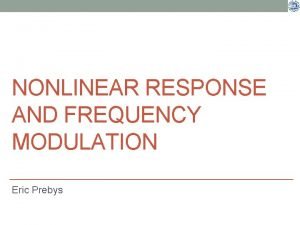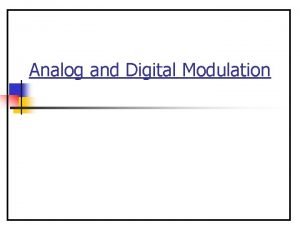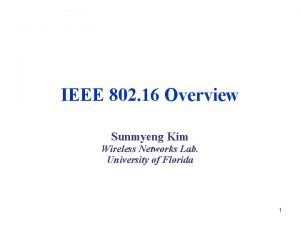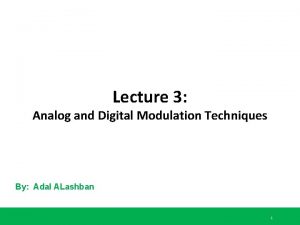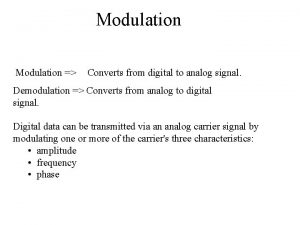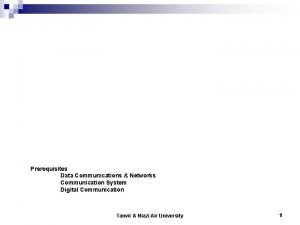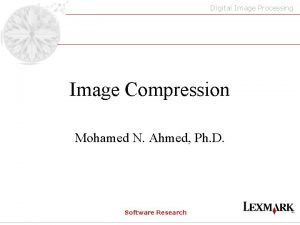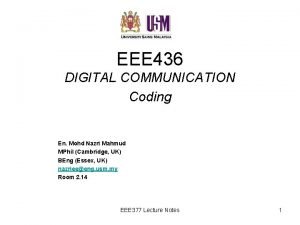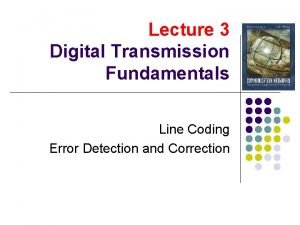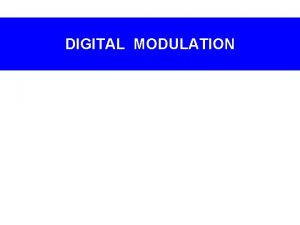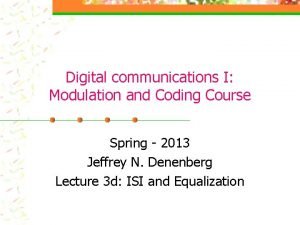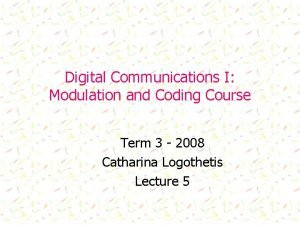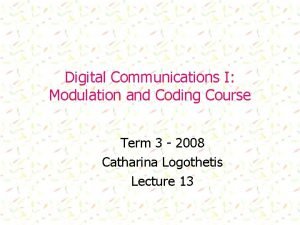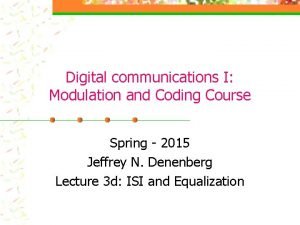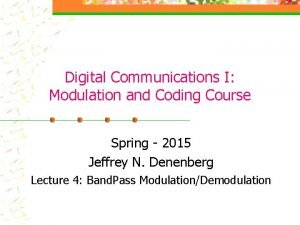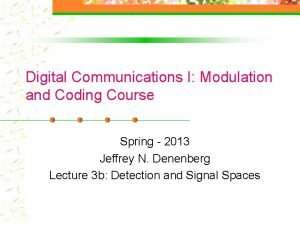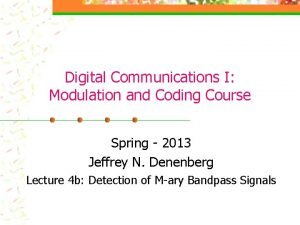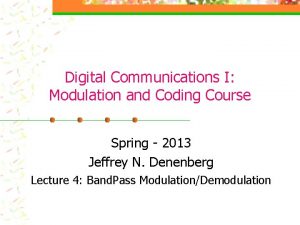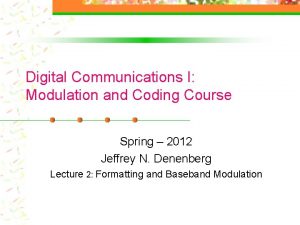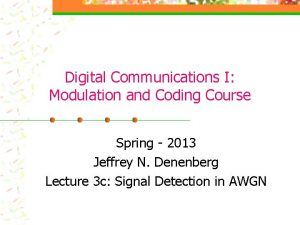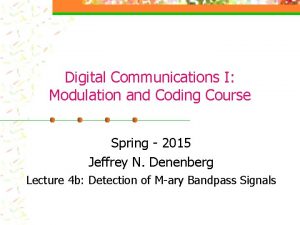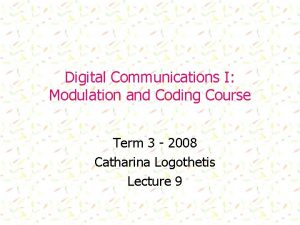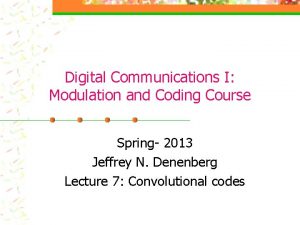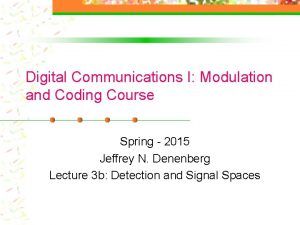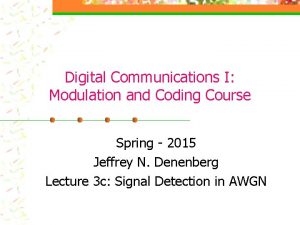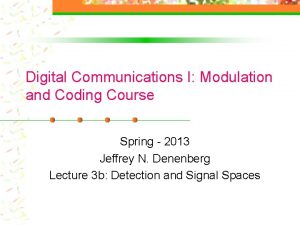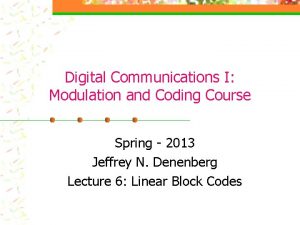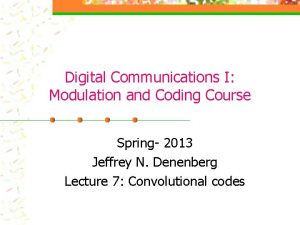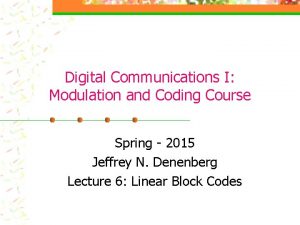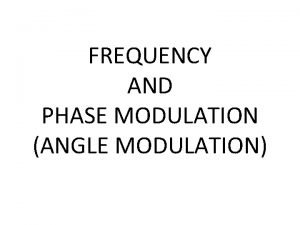Digital communications I Modulation and Coding Course Period












![Example of pulse shaping Square-root Raised-Cosine (SRRC) pulse shaping Amp. [V] Baseband tr. Waveform Example of pulse shaping Square-root Raised-Cosine (SRRC) pulse shaping Amp. [V] Baseband tr. Waveform](https://slidetodoc.com/presentation_image_h/e4645c27162223e0a54f778281cc2dfa/image-13.jpg)

















- Slides: 30

Digital communications I: Modulation and Coding Course Period 3 - 2007 Catharina Logothetis Lecture 6

Last time we talked about: Signal detection in AWGN channels Minimum distance detector Maximum likelihood Average probability of symbol error Union bound on error probability Upper bound on error probability based on the minimum distance Lecture 6 2

Today we are going to talk about: Another source of error: Inter-symbol interference (ISI) Nyquist theorem The techniques to reduce ISI Pulse shaping Equalization Lecture 6 3

Inter-Symbol Interference (ISI) ISI in the detection process due to the filtering effects of the system Overall equivalent system transfer function creates echoes and hence time dispersion causes ISI at sampling time Lecture 6 4

Inter-symbol interference Baseband system model Equivalent model Lecture 6 5

Nyquist bandwidth constraint Nyquist bandwidth constraint: The theoretical minimum required system bandwidth to detect Rs [symbols/s] without ISI is Rs/2 [Hz]. Equivalently, a system with bandwidth W=1/2 T=Rs/2 [Hz] can support a maximum transmission rate of 2 W=1/T=Rs [symbols/s] without ISI. Bandwidth efficiency, R/W [bits/s/Hz] : An important measure in DCs representing data throughput per hertz of bandwidth. Showing how efficiently the bandwidth resources are used by signaling techniques. Lecture 6 6

Ideal Nyquist pulse (filter) Ideal Nyquist filter Ideal Nyquist pulse Lecture 6 7

Nyquist pulses (filters) Nyquist pulses (filters): Nyquist filter: Its transfer function in frequency domain is obtained by convolving a rectangular function with any real even-symmetric frequency function Nyquist pulse: Pulses (filters) which results in no ISI at the sampling time. Its shape can be represented by a sinc(t/T) function multiply by another time function. Example of Nyquist filters: Raised-Cosine filter Lecture 6 8

Pulse shaping to reduce ISI Goals and trade-off in pulse-shaping Reduce ISI Efficient bandwidth utilization Robustness to timing error (small side lobes) Lecture 6 9

The raised cosine filter Raised-Cosine Filter A Nyquist pulse (No ISI at the sampling time) Roll-off factor Excess bandwidth: Lecture 6 10

The Raised cosine filter – cont’d 1 1 0. 5 0 0 Lecture 6 11

Pulse shaping and equalization to remove ISI No ISI at the sampling time Square-Root Raised Cosine (SRRC) filter and Equalizer Taking care of ISI caused by channel Lecture 6 12
![Example of pulse shaping Squareroot RaisedCosine SRRC pulse shaping Amp V Baseband tr Waveform Example of pulse shaping Square-root Raised-Cosine (SRRC) pulse shaping Amp. [V] Baseband tr. Waveform](https://slidetodoc.com/presentation_image_h/e4645c27162223e0a54f778281cc2dfa/image-13.jpg)
Example of pulse shaping Square-root Raised-Cosine (SRRC) pulse shaping Amp. [V] Baseband tr. Waveform Third pulse t/T First pulse Second pulse Data symbol Lecture 6 13

Example of pulse shaping … Raised Cosine pulse at the output of matched filter Amp. [V] Baseband received waveform at the matched filter output (zero ISI) t/T Lecture 6 14

Eye pattern Eye pattern: Display on an oscilloscope which sweeps the system response to a baseband signal at the rate 1/T (T symbol duration) Distortion due to ISI amplitude scale Noise margin Sensitivity to timing error Timing jitter time scale Lecture 6 15

Example of eye pattern: Binary-PAM, SRRQ pulse Perfect channel (no noise and no ISI) Lecture 6 16

Example of eye pattern: Binary-PAM, SRRQ pulse … AWGN (Eb/N 0=20 d. B) and no ISI Lecture 6 17

Example of eye pattern: Binary-PAM, SRRQ pulse … AWGN (Eb/N 0=10 d. B) and no ISI Lecture 6 18

Equalization – cont’d Step 1 – waveform to sample transformation Step 2 – decision making Demodulate & Sample Frequency down-conversion For bandpass signals Received waveform Receiving filter Detect Equalizing filter Threshold comparison Compensation for channel induced ISI Baseband pulse (possibly distored) Lecture 6 Baseband pulse Sample (test statistic) 19

Equalization ISI due to filtering effect of the communications channel (e. g. wireless channels) Channels behave like band-limited filters Non-constant amplitude Non-linear phase Amplitude distortion Phase distortion Lecture 6 20

Equalization: Channel examples Example of a frequency selective, slowly changing (slow fading) channel for a user at 35 km/h Lecture 6 21

Equalization: Channel examples … Example of a frequency selective, fast changing (fast fading) channel for a user at 35 km/h Lecture 6 22

Example of eye pattern with ISI: Binary-PAM, SRRQ pulse Non-ideal channel and no noise Lecture 6 23

Example of eye pattern with ISI: Binary-PAM, SRRQ pulse … AWGN (Eb/N 0=20 d. B) and ISI Lecture 6 24

Example of eye pattern with ISI: Binary-PAM, SRRQ pulse … AWGN (Eb/N 0=10 d. B) and ISI Lecture 6 25

Equalizing filters … Baseband system model Tx filter Channel Equalizer Rx. filter Detector Equivalent model Equivalent system Equalizer Detector filtered noise Lecture 6 26

Equalization – cont’d Equalization using MLSE (Maximum likelihood sequence estimation) Filtering Transversal filtering Decision feedback Zero-forcing equalizer Minimum mean square error (MSE) equalizer Using the past decisions to remove the ISI contributed by them Adaptive equalizer Lecture 6 27

Equalization by transversal filtering Transversal filter: A weighted tap delayed line that reduces the effect of ISI by proper adjustment of the filter taps. Coeff. adjustment Lecture 6 28

Transversal equalizing filter … Zero-forcing equalizer: The filter taps are adjusted such that the equalizer output is forced to be zero at N sample points on each side: Adjust Mean Square Error (MSE) equalizer: The filter taps are adjusted such that the MSE of ISI and noise power at the equalizer output is minimized. Adjust Lecture 6 29

Example of equalizer 2 -PAM with SRRQ Non-ideal channel One-tap DFE Matched filter outputs at the sampling time ISI-no noise, No equalizer ISI-no noise, DFE equalizer ISI- noise No equalizer ISI- noise DFE equalizer Lecture 6 30
 Selective coding adalah
Selective coding adalah Apa itu open coding
Apa itu open coding Amplitude modulation vs frequency modulation
Amplitude modulation vs frequency modulation Wave modulation
Wave modulation Advantages of angle modulation
Advantages of angle modulation Modulation coding scheme
Modulation coding scheme Coding dna and non coding dna
Coding dna and non coding dna Analog and digital modulation techniques
Analog and digital modulation techniques History of qualitative research
History of qualitative research Advantages of digital modulation
Advantages of digital modulation Modulation digital to analog
Modulation digital to analog Advantages of digital modulation
Advantages of digital modulation Digital communications and networks
Digital communications and networks Course title and course number
Course title and course number Managing digital communications
Managing digital communications Amateur radio digital communications
Amateur radio digital communications A&p flix activity: propagation of an action potential
A&p flix activity: propagation of an action potential Absolute refractory period and relative refractory period
Absolute refractory period and relative refractory period Trustee period and royal period
Trustee period and royal period Paleolithic age time period
Paleolithic age time period Error free compression
Error free compression Digital image processing
Digital image processing Eee
Eee Nrz i
Nrz i Image compression models in digital image processing
Image compression models in digital image processing How to install a lintel in a single brick wall
How to install a lintel in a single brick wall Chaine parallèle muscle
Chaine parallèle muscle The development of children 7th edition
The development of children 7th edition Critical period vs sensitive period
Critical period vs sensitive period Critical period
Critical period Approaches to child development
Approaches to child development


